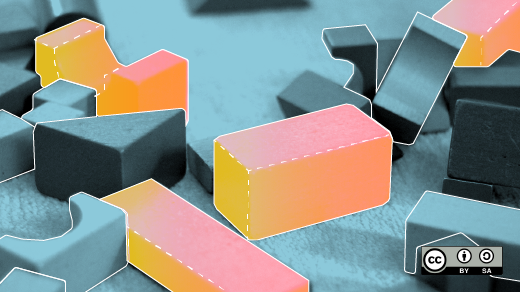Buildah 入门
======
> Buildah 提供一种灵活、可脚本编程的方式,来使用你熟悉的工具创建精简、高效的容器镜像。

[Buildah][1] 是一个命令行工具,可以方便、快捷的构建与[开放容器标准][2](OCI)兼容的容器镜像,这意味着其构建的镜像与 Docker 和 Kubernetes 兼容。该工具可作为 Docker 守护进程 `docker build` 命令(即使用传统的 Dockerfile 构建镜像)的一种简单替换,而且更加灵活,允许构建镜像时使用你擅长的工具。Buildah 可以轻松与脚本集成并生成流水线,最好之处在于构建镜像不再需要运行容器守护进程(LCTT 译注:这里主要是指 Docker 守护进程)。
### docker build 的简单替换
目前你可能使用 Dockerfile 和 `docker build` 命令构建镜像,那么你可以马上使用 Buildah 进行替代。Buildah 的 `build-using-dockerfile` (或 `bud`)子命令与 `docker build` 基本等价,因此可以轻松的与已有脚本结合或构建流水线。
类似我的上一篇关于 Buildah 的[文章][3],我也将以使用源码安装 “GNU Hello” 为例进行说明,对应的 Dockerfile 文件如下:
```
FROM fedora:28
LABEL maintainer Chris Collins
RUN dnf install -y tar gzip gcc make \
&& dnf clean all
ADD http://ftpmirror.gnu.org/hello/hello-2.10.tar.gz /tmp/hello-2.10.tar.gz
RUN tar xvzf /tmp/hello-2.10.tar.gz -C /opt
WORKDIR /opt/hello-2.10
RUN ./configure
RUN make
RUN make install
RUN hello -v
ENTRYPOINT "/usr/local/bin/hello"
```
使用 Buildah 从 Dockerfile 构建镜像也很简单,使用 `buildah bud -t hello .` 替换 `docker build -t hello .` 即可:
```
[chris@krang] $ sudo buildah bud -t hello .
STEP 1: FROM fedora:28
Getting image source signatures
Copying blob sha256:e06fd16225608e5b92ebe226185edb7422c3f581755deadf1312c6b14041fe73
81.48 MiB / 81.48 MiB [====================================================] 8s
Copying config sha256:30190780b56e33521971b0213810005a69051d720b73154c6e473c1a07ebd609
2.29 KiB / 2.29 KiB [======================================================] 0s
Writing manifest to image destination
Storing signatures
STEP 2: LABEL maintainer Chris Collins
STEP 3: RUN dnf install -y tar gzip gcc make && dnf clean all
<考虑篇幅,略去后续输出>
```
镜像构建完毕后,可以使用 `buildah images` 命令查看这个新镜像:
```
[chris@krang] $ sudo buildah images
IMAGE ID IMAGE NAME CREATED AT SIZE
30190780b56e docker.io/library/fedora:28 Mar 7, 2018 16:53 247 MB
6d54bef73e63 docker.io/library/hello:latest May 3, 2018 15:24 391.8 MB
```
新镜像的标签为 `hello:latest`,我们可以将其推送至远程镜像仓库,可以使用 [CRI-O][4] 或其它 Kubernetes CRI 兼容的运行时来运行该镜像,也可以推送到远程仓库。如果你要测试对 Docker build 命令的替代性,你可以将镜像拷贝至 docker 守护进程的本地镜像存储中,这样 Docker 也可以使用该镜像。使用 `buildah push` 可以很容易的完成推送操作:
```
[chris@krang] $ sudo buildah push hello:latest docker-daemon:hello:latest
Getting image source signatures
Copying blob sha256:72fcdba8cff9f105a61370d930d7f184702eeea634ac986da0105d8422a17028
247.02 MiB / 247.02 MiB [==================================================] 2s
Copying blob sha256:e567905cf805891b514af250400cc75db3cb47d61219750e0db047c5308bd916
144.75 MiB / 144.75 MiB [==================================================] 1s
Copying config sha256:6d54bef73e638f2e2dd8b7bf1c4dfa26e7ed1188f1113ee787893e23151ff3ff
1.59 KiB / 1.59 KiB [======================================================] 0s
Writing manifest to image destination
Storing signatures
[chris@krang] $ sudo docker images | head -n2
REPOSITORY TAG IMAGE ID CREATED SIZE
docker.io/hello latest 6d54bef73e63 2 minutes ago 398 MB
[chris@krang] $ sudo docker run -t hello:latest
Hello, world!
```
### 若干差异
与 Docker build 不同,Buildah 不会自动的将 Dockerfile 中的每条指令产生的变更提到新的分层中,只是简单的每次从头到尾执行构建。类似于自动化和流水线构建,这种无缓存构建方式的好处是可以提高构建速度,在指令较多时尤为明显。从自动部署或持续交付的视角来看,使用这种方式可以快速的将新变更落实到生产环境中。
但从实际角度出发,缓存机制的缺乏对镜像开发不利,毕竟缓存层可以避免一遍遍的执行构建,从而显著的节省时间。自动分层只在 `build-using-dockerfile` 命令中生效。但我们在下面会看到,Buildah 原生命令允许我们选择将变更提交到硬盘的时间,提高了开发的灵活性。
### Buildah 原生命令
Buildah _真正_ 有趣之处在于它的原生命令,你可以在容器构建过程中使用这些命令进行交互。相比与使用 `build-using-dockerfile/bud` 命令执行每次构建,Buildah 提供命令让你可以与构建过程中的临时容器进行交互。(Docker 也使用临时或 _中间_ 容器,但你无法在镜像构建过程中与其交互。)
还是使用 “GNU Hello” 为例,考虑使用如下 Buildah 命令构建的镜像:
```
#!/usr/bin/env bash
set -o errexit
# Create a container
container=$(buildah from fedora:28)
# Labels are part of the "buildah config" command
buildah config --label maintainer="Chris Collins " $container
# Grab the source code outside of the container
curl -sSL http://ftpmirror.gnu.org/hello/hello-2.10.tar.gz -o hello-2.10.tar.gz
buildah copy $container hello-2.10.tar.gz /tmp/hello-2.10.tar.gz
buildah run $container dnf install -y tar gzip gcc make
buildah run $container dnf clean all
buildah run $container tar xvzf /tmp/hello-2.10.tar.gz -C /opt
# Workingdir is also a "buildah config" command
buildah config --workingdir /opt/hello-2.10 $container
buildah run $container ./configure
buildah run $container make
buildah run $container make install
buildah run $container hello -v
# Entrypoint, too, is a “buildah config” command
buildah config --entrypoint /usr/local/bin/hello $container
# Finally saves the running container to an image
buildah commit --format docker $container hello:latest
```
我们可以一眼看出这是一个 Bash 脚本而不是 Dockerfile。基于 Buildah 的原生命令,可以轻易的使用任何脚本语言或你擅长的自动化工具编写脚本。形式可以是 makefile、Python 脚本或其它你擅长的类型。
这个脚本做了哪些工作呢?首先,Buildah 命令 `container=$(buildah from fedora:28)` 基于 fedora:28 镜像创建了一个正在运行的容器,将容器名(`buildah from` 命令的返回值)保存到变量中,便于后续使用。后续所有命令都是有 `$container` 变量指明需要操作的容器。这些命令的功能大多可以从名称看出:`buildah copy` 将文件拷贝至容器,`buildah run` 会在容器中执行命令。可以很容易的将上述命令与 Dockerfile 中的指令对应起来。
最后一条命令 `buildah commit` 将容器提交到硬盘上的镜像中。当不使用 Dockerfile 而是使用 Buildah 命令构建镜像时,你可以使用 `commit` 命令决定何时保存变更。在上例中,所有的变更是一起提交的;但也可以增加中间提交,让你可以选择作为起点的缓存点。(例如,执行完 `dnf install` 命令后将变更缓存到硬盘是特别有意义的,一方面因为该操作耗时较长,另一方面每次执行的结果也确实相同。)
### 挂载点,安装目录以及 chroot
另一个可以大大增加构建镜像灵活性的 Buildah 命令是 `buildah mount`,可以将容器的根目录挂载到你主机的一个挂载点上。例如:
```
[chris@krang] $ container=$(sudo buildah from fedora:28)
[chris@krang] $ mountpoint=$(sudo buildah mount ${container})
[chris@krang] $ echo $mountpoint
/var/lib/containers/storage/overlay2/463eda71ec74713d8cebbe41ee07da5f6df41c636f65139a7bd17b24a0e845e3/merged
[chris@krang] $ cat ${mountpoint}/etc/redhat-release
Fedora release 28 (Twenty Eight)
[chris@krang] $ ls ${mountpoint}
bin dev home lib64 media opt root sbin sys usr
boot etc lib lost+found mnt proc run srv tmp var
```
这太棒了,你可以通过与挂载点交互对容器镜像进行修改。这允许你使用主机上的工具进行构建和安装软件,不用将这些构建工具打包到容器镜像本身中。例如,在我们上面的 Bash 脚本中,我们需要安装 tar、Gzip、GCC 和 make,在容器内编译 “GNU Hello”。如果使用挂载点,我仍使用同样的工具进行构建,但下载的压缩包和 tar、Gzip 等 RPM 包都在主机而不是容器和生成的镜像内:
```
#!/usr/bin/env bash
set -o errexit
# Create a container
container=$(buildah from fedora:28)
mountpoint=$(buildah mount $container)
buildah config --label maintainer="Chris Collins " $container
curl -sSL http://ftpmirror.gnu.org/hello/hello-2.10.tar.gz \
-o /tmp/hello-2.10.tar.gz
tar xvzf src/hello-2.10.tar.gz -C ${mountpoint}/opt
pushd ${mountpoint}/opt/hello-2.10
./configure
make
make install DESTDIR=${mountpoint}
popd
chroot $mountpoint bash -c "/usr/local/bin/hello -v"
buildah config --entrypoint "/usr/local/bin/hello" $container
buildah commit --format docker $container hello
buildah unmount $container
```
在上述脚本中,需要提到如下几点:
1. `curl` 命令将压缩包下载到主机中,而不是镜像中;
2. (主机中的) `tar` 命令将压缩包中的源代码解压到容器的 `/opt` 目录;
3. `configure`,`make` 和 `make install` 命令都在主机的挂载点目录中执行,而不是在容器内;
4. 这里的 `chroot` 命令用于将挂载点本身当作根路径并测试 "hello" 是否正常工作;类似于前面例子中用到的 `buildah run` 命令。
这个脚本更加短小,使用大多数 Linux 爱好者都很熟悉的工具,最后生成的镜像也更小(没有 tar 包,没有额外的软件包等)。你甚至可以使用主机系统上的包管理器为容器安装软件。例如,(出于某种原因)你希望安装 GNU Hello 的同时在容器中安装 [NGINX][5]:
```
[chris@krang] $ mountpoint=$(sudo buildah mount ${container})
[chris@krang] $ sudo dnf install nginx --installroot $mountpoint
[chris@krang] $ sudo chroot $mountpoint nginx -v
nginx version: nginx/1.12.1
```
在上面的例子中,DNF 使用 `--installroot` 参数将 NGINX 安装到容器中,可以通过 chroot 进行校验。
### 快来试试吧!
Buildah 是一种轻量级、灵活的容器镜像构建方法,不需要在主机上运行完整的 Docker 守护进程。除了提供基于 Dockerfile 构建容器的开箱即用支持,Buildah 还可以很容易的与脚本或你喜欢的构建工具相结合,特别是可以使用主机上已有的工具构建容器镜像。Buildah 生成的容器体积更小,更便于网络传输,占用更小的存储空间,而且潜在的受攻击面更小。快来试试吧!
**[阅读相关的故事,[使用 Buildah 创建小体积的容器][6]]**
--------------------------------------------------------------------------------
via: https://opensource.com/article/18/6/getting-started-buildah
作者:[Chris Collins][a]
选题:[lujun9972](https://github.com/lujun9972)
译者:[pinewall](https://github.com/pinewall)
校对:[wxy](https://github.com/wxy)
本文由 [LCTT](https://github.com/LCTT/TranslateProject) 原创编译,[Linux中国](https://linux.cn/) 荣誉推出
[a]:https://opensource.com/users/clcollins
[1]:https://github.com/projectatomic/buildah
[2]:https://www.opencontainers.org/
[3]:http://chris.collins.is/2017/08/17/buildah-a-new-way-to-build-container-images/
[4]:http://cri-o.io/
[5]:https://www.nginx.com/
[6]:https://linux.cn/article-9719-1.html